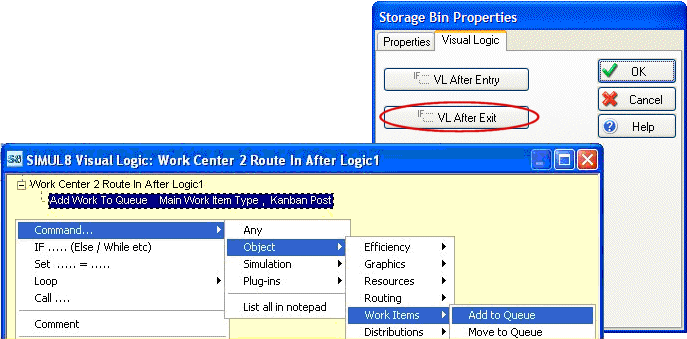In this tutorial, you'll learn how SIMUL8 can be used to simulate both push and pull systems. We'll also explain how SIMUL8 can be used to analyze a production system using key performance indicators (KPIs):
- Lead times
- WIP Levels
- Throughput
Adjacent machines on a production line often operate at different speeds. As a result, some “buffer” inventory is often required to ensure that parts are always available for downstream machines. These buffers prevent the starvation of downstream machines and the reduction of throughput. As the variation in machine cycle times increases, the size of the buffers must also increase, to combat the increased likelihood of machine starvation.
The high inventory levels created by this approach lead to higher inventory storage costs, as well as longer times for orders to move through the system. As consumers demand ever-faster response times, production managers must identify new ways of reducing lead times without sacrificing throughput.
By applying Lean manufacturing techniques, it is possible to reduce Work-In-Progress (WIP) and lead times without significantly lowering machine utilization and throughput. Lean manufacturing replaces the traditional “push” system of production with a “pull” system.
What are the key differences between push and pull systems?
In a push system, the focus of production is on the upstream machines; downstream machines perform work as soon as parts are available from those upstream. In a pull system however, the focus shifts to the downstream machines; upstream machines only perform work when downstream ones request it. The result is a reduction in required inventory levels, as well as shorter lead times throughout the system.
The traditional “Push” System
SIMUL8 models operate by default under a push workflow scenario. Activities process work items as they become available, on a first in first out basis. Under these circumstances, restricting inventory levels can negatively impact system performance. The following example demonstrates the tradeoff between WIP and lead time, and machine utilization and throughput.
Figure 1 shows a simple two process simulation with buffers using the default parameters provided by SIMUL8.

Figure 1. A simple two-process push system simulation.
In order to analyze the simulation, the results listed below are added to the Results Summary sheet, and a trial is performed.
- Work Exit Point: Number Completed, Average Time in System
- Activities: Working %
- Queues: Average Queue Size
To evaluate the impact of reducing inventory, a new trial is performed and the results examined again after capacities of all Queues are lowered to one.
To compare results of the different trials select the “Compare Results” button on the Result Summary. As shown in the figure below, the results demonstrate that in a push system, decreasing inventory levels results in decreased throughput and machine utilization.

Figure 2. Sample results from two trials.
Simulating “pull” systems using Kanbans
Lean manufacturing techniques are being used to introduce pull systems into manufacturing facilities. The essential characteristic of all pull systems is that upstream operations process only enough material to satisfy the needs of downstream operations. Instead of producing to satisfy total demand from a forecast, upstream operations are regulated to produce in accordance to downstream requirements. These requirements are typically communicated through a physical card known as a “Kanban”.

Figure 3. A two-process pull system simulation.
In a Kanban system, the upstream process waits for a signal from a downstream operation to begin work. This working relationship can be simulated in SIMUL8 using the following four steps:
- Remove Queue for Activity 1, and set the Work Entry Arrivals to Unlimited.
- Create a Queue (call it Kanban Post) that feeds Activity 1, with a Start-up Inventory of 1.
- Set Activity 1 to collect both a Kanban from this Queue and a Work Item from the Work Entry point. This will restrict Activity 1 from working if there is no Kanban available.
- As soon as work commences in Activity 2, use the following Visual Logic command to return a Kanban to the Kanban Post.

Figure 4. Visual Logic command to be inserted either: (a) in Activity 2’s Route-In After Loading logic, or (b) in the Queue’s After Exit logic (if using SIMUL8 2005)
Alternatively, the new Queue After Exit Logic can be used to trigger this event.
Using the Kanban, the system will be able to achieve lower lead times, due to reduced inventory levels before and after Activity 1. The pull system eliminates the need to limit the inventory level in the buffer between Activities 1 and 2. Activity 1 will only produce the amount of inventory required to keep Activity 2 busy, without overproducing.
It is possible to experiment with the number of Kanbans within the system to further improve work flow and throughput, as shown below. This simple demonstration is at the heart of the popular Supermarket concept in lean manufacturing.

Figure 5. Results Comparison from a 1 and 2 Kanban system.
The simulation results show the advantages of a pull system. By limiting the need for large buffers between machines, the Kanbans effectively reduce inventory but still maintain high machine utilization.
SIMUL8 can be used to design production pull systems by analyzing the process before and after the introduction of Kanbans in a risk-free “what-if” setting. Using simulation you can answer questions such as:
- How many Kanbans do I need (in a supermarket) to achieve a 99% service level?
- To which upstream process should I send the Kanbans to optimize response times?
- What would be the effect of combining a number of processes into one work cell?